Dry climate gardening presents unique challenges, but with the right approach, you can create a thriving garden of edible and medicinal succulents and cacti. These resilient plants not only conserve water but also provide nutritional and medicinal benefits that have been valued for centuries. Whether you’re dealing with limited space, water restrictions, or simply want to explore sustainable gardening practices, this guide will help you harness the remarkable potential of these drought-resistant plants.
Benefits of Growing Edible and Medicinal Succulents
Succulents and cacti have evolved remarkable adaptations that make them perfect candidates for dry climate gardening. Their water-storing capabilities allow them to thrive in conditions where other plants would struggle to survive. Here’s why they deserve a place in your garden:
Water Conservation
Succulents and cacti require significantly less water than conventional garden plants. Their specialized tissues store water efficiently, reducing the need for frequent irrigation. This makes them ideal for regions experiencing drought conditions or water restrictions.
Space Efficiency
Many edible succulents and cacti grow well in containers and vertical gardens, making them perfect for small spaces. Their compact growth habits allow you to maximize production in limited areas, whether on a balcony, patio, or small yard.
Nutritional Value
Edible succulents like purslane and prickly pear are packed with nutrients, including vitamins, minerals, and antioxidants. Many contain unique compounds not commonly found in conventional vegetables, adding diversity to your diet.
Medicinal Properties
From aloe vera’s soothing gel to the anti-inflammatory properties of prickly pear, many succulents and cacti have been used in traditional medicine for centuries. Growing your own gives you access to these natural remedies right outside your door.
Choosing the Right Edible and Medicinal Succulents
Not all succulents and cacti are created equal when it comes to edibility and medicinal properties. Here are some of the best varieties to consider for your dry climate garden:
Top Edible Succulents for Dry Climates
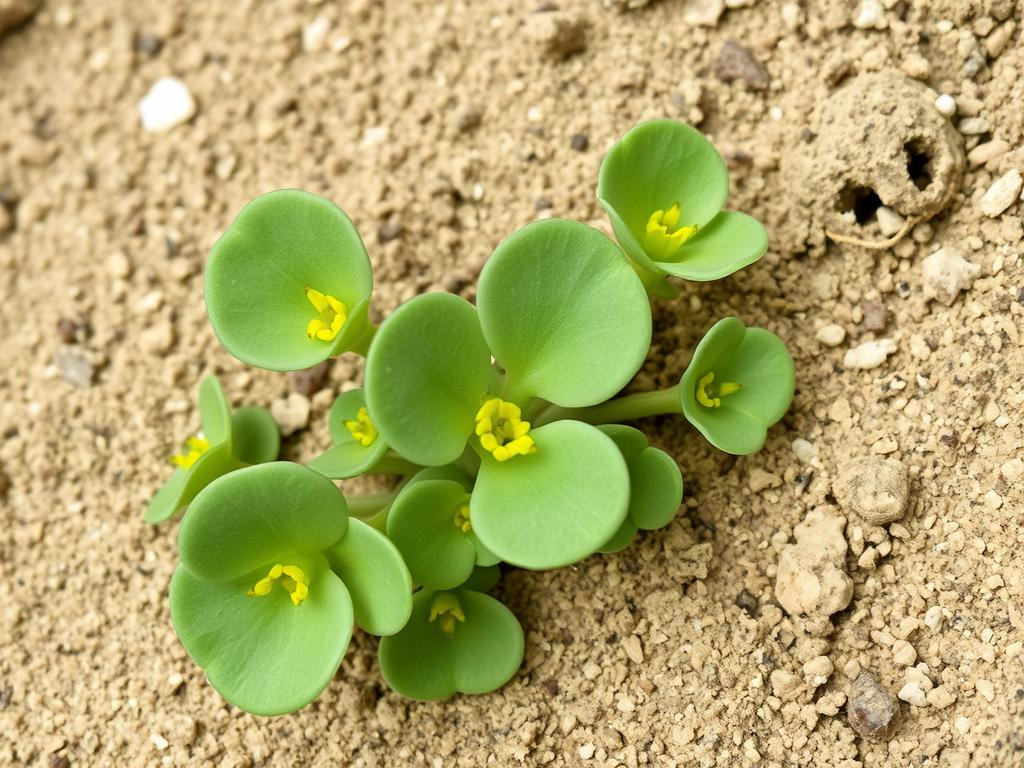
Purslane (Portulaca oleracea)
- Edible parts: Leaves, stems, and flowers
- Flavor profile: Slightly tangy with a lemony taste
- Nutritional benefits: Rich in omega-3 fatty acids, vitamins A, C, and E
- Growing difficulty: Very easy, often grows wild
- Water needs: Low, drought-tolerant once established
Prickly Pear Cactus (Opuntia)
- Edible parts: Pads (nopales) and fruits (tunas)
- Flavor profile: Pads taste similar to green beans; fruits are sweet like watermelon
- Nutritional benefits: High in fiber, antioxidants, and vitamin C
- Growing difficulty: Easy to moderate
- Water needs: Very low, extremely drought-tolerant
Dragon Fruit (Hylocereus undatus)
- Edible parts: Fruit
- Flavor profile: Mildly sweet with a texture similar to kiwi
- Nutritional benefits: Contains vitamin C, phosphorus, calcium, and fiber
- Growing difficulty: Moderate
- Water needs: Low to moderate
Medicinal Succulents and Cacti
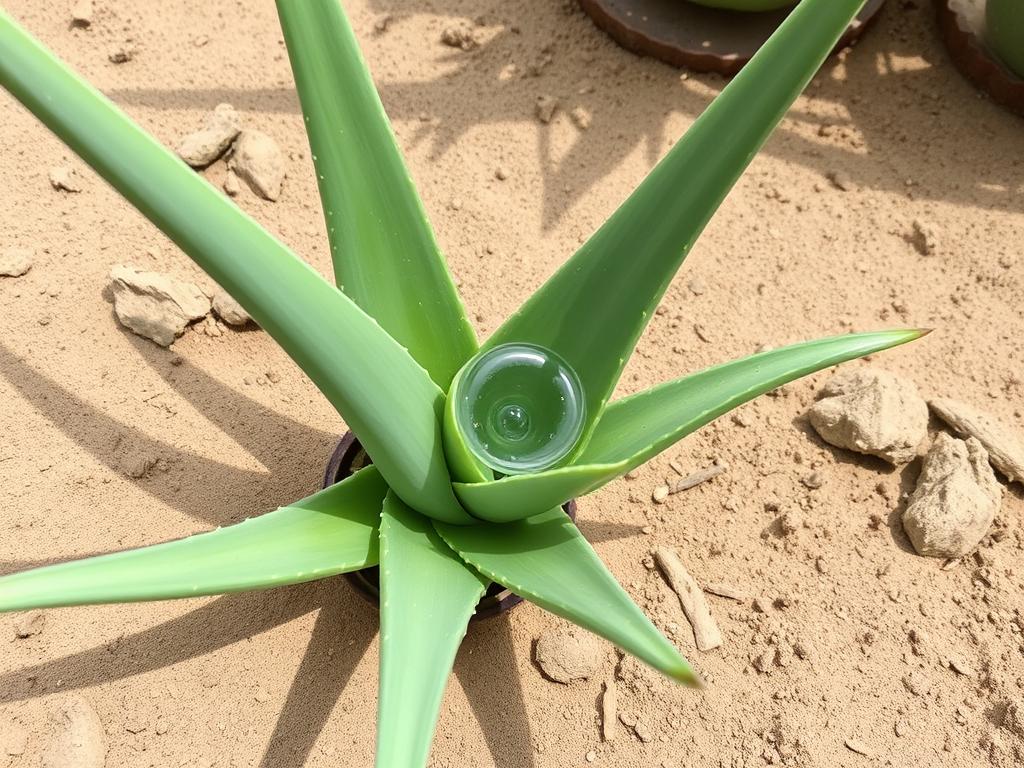
Aloe Vera (Aloe barbadensis miller)
- Medicinal uses: Skin conditions, burns, wound healing
- Active compounds: Aloin, emodin, and acemannan
- Growing difficulty: Easy
- Water needs: Low, sensitive to overwatering
- Harvest method: Cut outer leaves at the base, extract gel
Agave (Agave americana)
- Medicinal uses: Anti-inflammatory, wound healing
- Active compounds: Saponins, inulin
- Growing difficulty: Easy
- Water needs: Very low
- Harvest method: Carefully extract sap from mature plants
Elephant Bush (Portulacaria afra)
- Medicinal uses: Skin conditions, sore throat
- Active compounds: Flavonoids, polyphenols
- Growing difficulty: Easy
- Water needs: Low
- Harvest method: Pick young leaves as needed
Want to Learn More About Medicinal Plants?
Subscribe to our newsletter for monthly tips on growing and using medicinal plants in your home garden.
Setting Up Your Succulent and Cacti Garden
Creating the right growing environment is crucial for the success of your edible and medicinal succulents and cacti. These plants have specific needs that differ from conventional garden plants.
Choosing the Right Location
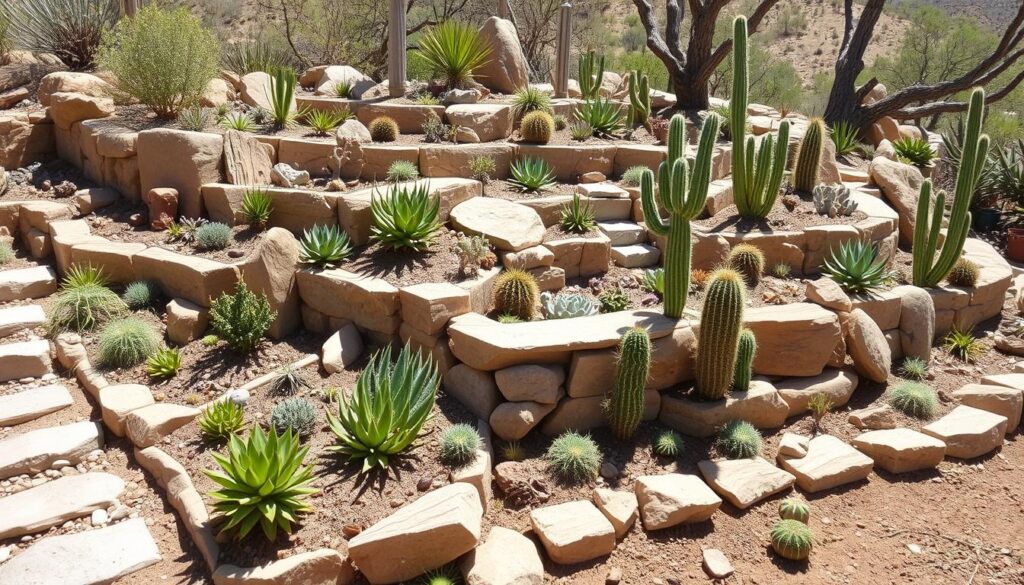
Most edible and medicinal succulents and cacti require abundant sunlight to thrive. Here’s what to consider when selecting a location:
- Choose a spot that receives at least 6-8 hours of direct sunlight daily
- South or west-facing locations are typically ideal in the Northern Hemisphere
- Consider protection from extreme afternoon heat in very hot climates
- Ensure good air circulation to prevent fungal issues
- Select a location with excellent drainage to prevent root rot
Soil and Drainage Requirements
The right soil mix is critical for growing healthy succulents and cacti. These plants evolved in environments with poor, fast-draining soil and will quickly rot if kept too wet.
“The number one killer of succulents and cacti is overwatering, which often results from poorly draining soil. When in doubt, add more drainage material.”
DIY Succulent Soil Recipe
- Start with 3 parts regular potting soil
- Add 2 parts coarse sand (not beach sand)
- Mix in 1 part perlite or pumice
- For cacti, increase the sand and perlite/pumice ratio
- Optional: Add a small amount of compost for nutrients
Container and Vertical Gardening Solutions
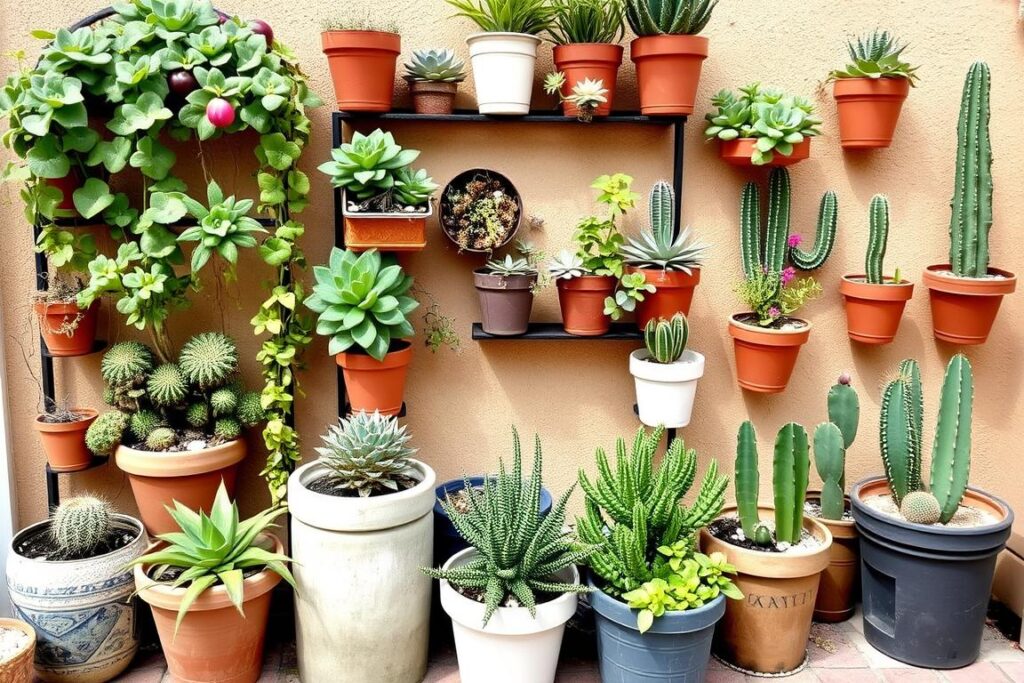
Limited space doesn’t mean limited growing options. Succulents and cacti are perfect candidates for container and vertical gardening:
Container Selection
- Choose containers with drainage holes
- Unglazed terracotta pots allow excess moisture to evaporate
- Deeper pots work better for cacti with taproots
- Shallow, wide containers are ideal for rosette-forming succulents
- Consider the mature size of your plants when selecting containers
Vertical Garden Ideas
- Repurposed pallets lined with landscape fabric
- Wall-mounted pocket planters
- Tiered plant stands
- Hanging baskets for trailing varieties
- Stacked containers in a pyramid formation
Water-Smart Care Techniques for Dry Climates
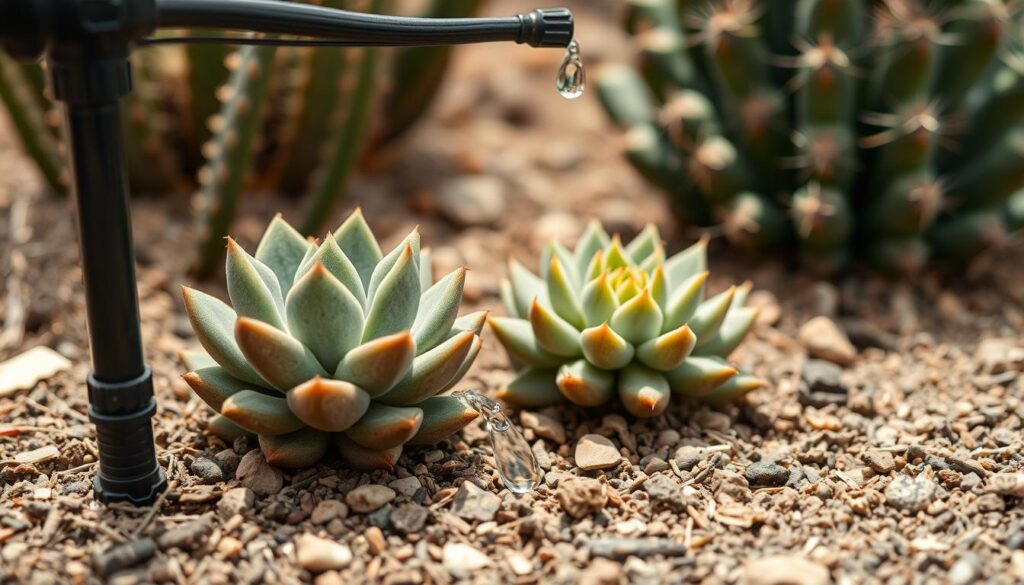
Proper watering is the most critical aspect of growing succulents and cacti successfully. These plants have evolved to survive in arid conditions and can easily be killed by overwatering.
Watering Principles for Succulents and Cacti
- Water deeply but infrequently to encourage deep root growth
- Allow soil to dry out completely between waterings
- Water at the base of plants to keep foliage dry
- Reduce watering significantly during dormant periods
- Increase watering slightly during active growth and flowering
The Soak and Dry Method: Water thoroughly until water runs from drainage holes, then allow the soil to dry completely before watering again. For most succulents and cacti in dry climates, this means watering every 2-3 weeks during growing season and even less frequently during dormancy.
Efficient Irrigation Systems
Setting up an efficient irrigation system can save water and time while ensuring your plants receive consistent moisture:
Drip Irrigation
- Delivers water directly to the root zone
- Minimizes evaporation and runoff
- Can be connected to timers for automation
- Adjustable emitters allow customization for different plants
Rainwater Harvesting
- Collect rainwater in barrels or cisterns
- Use for supplemental irrigation during dry periods
- Reduces dependence on municipal water
- Rainwater is free of chemicals found in tap water
Mulching for Water Conservation
While traditional organic mulches can hold too much moisture for succulents and cacti, inorganic mulches can help conserve water and regulate soil temperature:
- Small gravel or decomposed granite
- Pebbles or river rocks
- Crushed stone in colors that complement your plants
- Apply a 1-2 inch layer around plants, keeping mulch away from stems
Master Water-Smart Gardening
Download our free guide to efficient irrigation techniques for dry climate gardens.
Seasonal Care and Maintenance
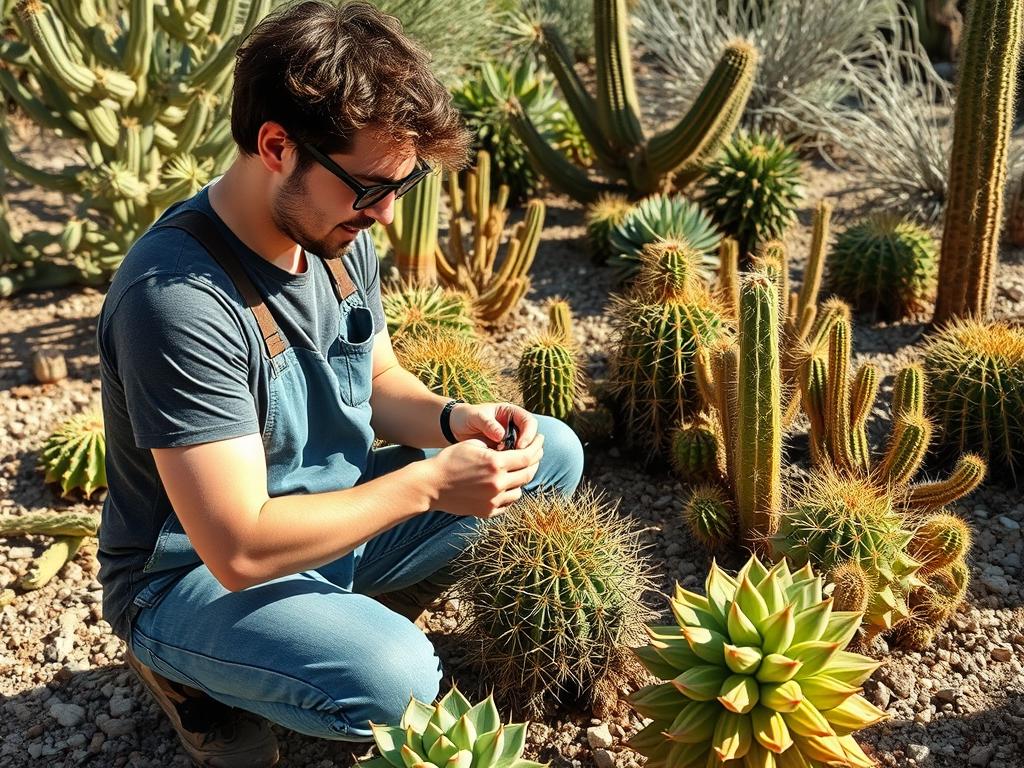
Succulents and cacti require different care throughout the year as they go through natural growth cycles. Understanding these cycles helps you provide optimal care in each season.
Spring Care
- Resume regular watering as plants come out of winter dormancy
- Apply a balanced, low-nitrogen fertilizer diluted to half strength
- Remove any winter protection as temperatures stabilize
- Repot crowded plants before active growth begins
- Start propagating new plants from cuttings
Summer Care
- Provide afternoon shade for sensitive varieties during extreme heat
- Water in the early morning to reduce evaporation
- Monitor for pests which are more active in warm weather
- Harvest fruits and edible parts as they mature
- Protect newly planted succulents from intense sun
Fall Care
- Gradually reduce watering as temperatures cool
- Stop fertilizing to prepare plants for dormancy
- Take cuttings for indoor growing during winter
- Clean up dead leaves and debris to prevent pest issues
- Harvest and process medicinal plants before frost
Winter Protection
While many succulents and cacti are drought-tolerant, not all are cold-hardy. In regions with freezing temperatures, winter protection is essential:
For Container Plants
- Move containers to protected areas or indoors
- Reduce watering significantly during dormancy
- Provide bright light if keeping indoors
- Avoid fertilizing during winter months
For Garden Plants
- Cover with frost cloth or burlap during freezes
- Apply a layer of gravel mulch to insulate roots
- Plant in protected microclimates near walls or rocks
- Select cold-hardy varieties for areas with harsh winters
Managing Pests and Diseases

While succulents and cacti tend to have fewer pest and disease problems than many other plants, they can still face challenges. Early detection and intervention are key to maintaining healthy plants.
Common Pests
| Pest | Signs | Natural Control Methods |
| Mealybugs | White, cotton-like clusters in leaf joints and crevices | Dab with alcohol on a cotton swab; spray with neem oil solution |
| Scale Insects | Brown or black bumps on stems and leaves | Scrape off gently; apply horticultural oil |
| Spider Mites | Fine webbing; stippled, discolored leaves | Increase humidity; spray with water; apply insecticidal soap |
| Aphids | Clusters of small insects on new growth; sticky residue | Spray with water; introduce beneficial insects; neem oil spray |
Disease Prevention and Treatment
Most diseases affecting succulents and cacti are related to improper growing conditions, particularly overwatering:
Root Rot
- Caused by overwatering and poor drainage
- Symptoms: Soft, discolored stems; blackened roots
- Treatment: Remove affected parts; repot in fresh, dry soil
- Prevention: Well-draining soil; proper watering schedule
Fungal Infections
- Often appear as spots or powdery patches
- Symptoms: Discolored spots; unusual growth
- Treatment: Remove affected parts; apply fungicide
- Prevention: Good air circulation; avoid overhead watering
Important: Always quarantine new plants for at least two weeks before introducing them to your collection. This helps prevent the spread of pests and diseases to your established plants.
Harvesting and Using Edible and Medicinal Succulents
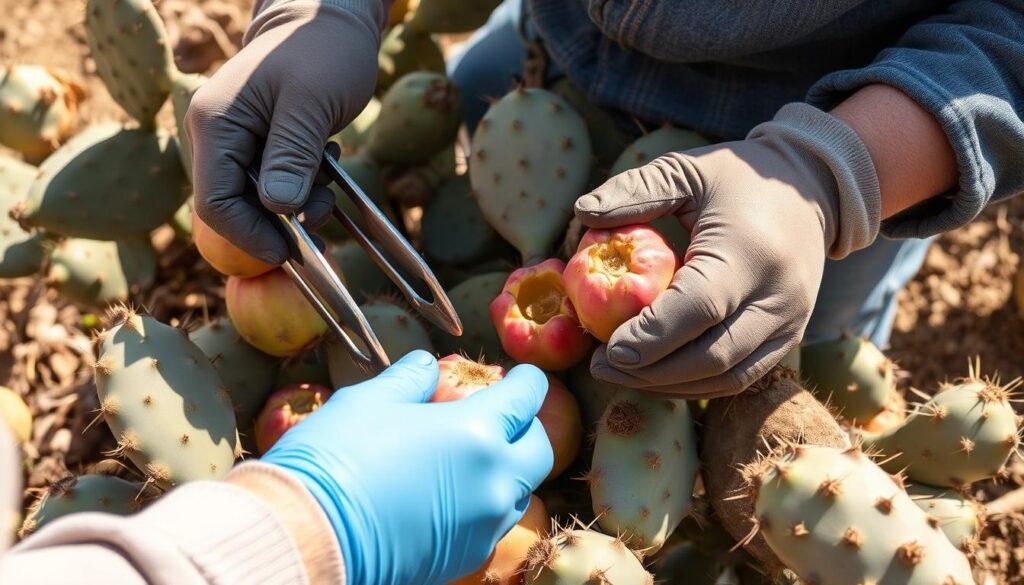
Knowing when and how to harvest your succulents and cacti is essential for both plant health and optimal flavor or medicinal potency. Each variety has specific harvesting requirements.
Safe Harvesting Techniques
Many edible and medicinal succulents and cacti have protective mechanisms like spines or irritating sap that require careful handling:
Tools You’ll Need
- Thick gardening gloves (leather or specialized cactus gloves)
- Long tongs for handling spiny parts
- Sharp, clean pruning shears or knife
- Collection basket or container
- Brush for removing glochids (tiny spines)
Harvesting Tips
- Harvest in the morning when plants are well-hydrated
- Make clean cuts to minimize damage to the plant
- Leave enough of the plant to ensure continued growth
- Process harvested parts promptly for best quality
- Wear protective clothing to prevent skin irritation
Specific Harvesting Guidelines
Prickly Pear (Opuntia)
- Pads (Nopales): Harvest young pads when 4-6 inches long; cut at the joint
- Fruits (Tunas): Harvest when fully colored but still firm; twist gently to remove
- Processing: Remove spines by singeing over flame or scraping with knife
- Storage: Pads keep 1-2 weeks refrigerated; fruits 3-5 days
Aloe Vera
- Leaves: Harvest outer, mature leaves by cutting at the base
- Timing: Plants should be at least 8-12 inches tall before first harvest
- Processing: Slice open leaf and scoop out gel; rinse to remove yellow aloin
- Storage: Fresh gel keeps 1 week refrigerated; can be frozen in cubes
Purslane
- Parts: Harvest young stems and leaves by pinching or cutting
- Timing: Harvest before flowering for best flavor
- Processing: Wash thoroughly to remove soil; use fresh or blanch for freezing
- Storage: Keeps 3-5 days refrigerated in a damp paper towel
Simple Recipes and Remedies

Nopales Salad
- Remove spines from 4 young prickly pear pads
- Dice into 1/2-inch pieces
- Boil in salted water for 5-8 minutes until tender
- Drain and rinse with cold water
- Toss with diced tomato, onion, cilantro, lime juice, and salt
Aloe Vera Sunburn Relief
- Cut a mature aloe leaf from the plant
- Slice open lengthwise and scoop out the clear gel
- Rinse to remove yellow aloin (which can irritate skin)
- Apply directly to sunburned skin
- Store remaining gel in refrigerator for up to one week
Expand Your Succulent Culinary Skills
Join our online workshop to learn more recipes and preparation techniques for edible succulents and cacti.
Propagating Edible and Medicinal Succulents
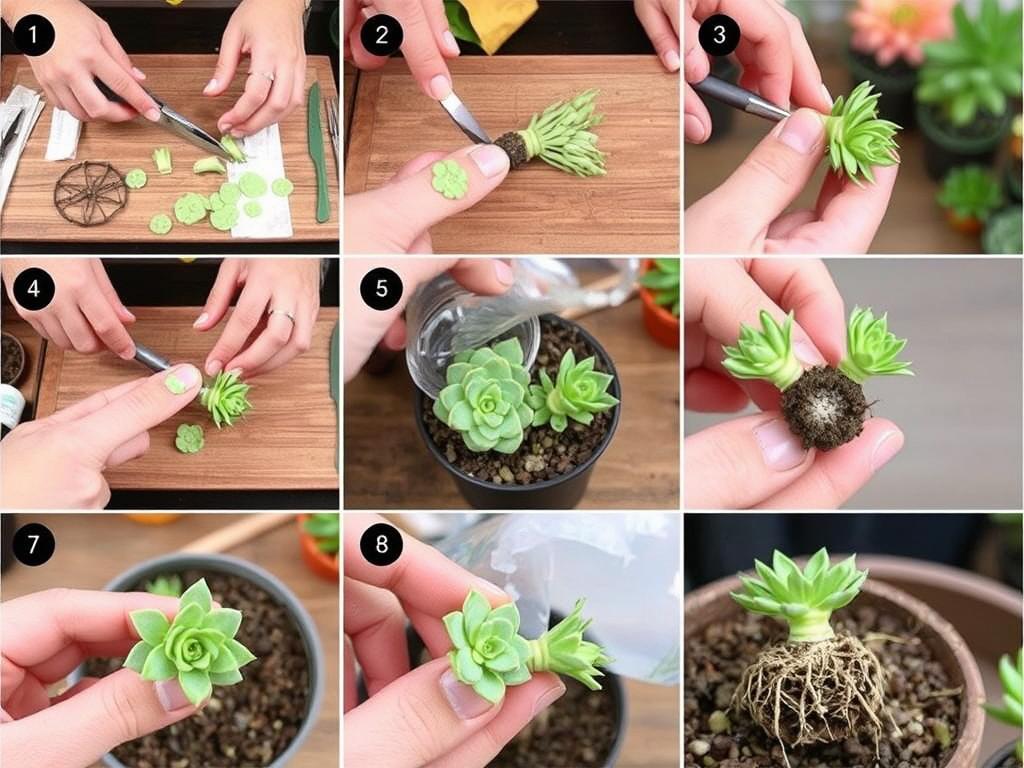
One of the most rewarding aspects of growing succulents and cacti is how easily many species can be propagated. This allows you to expand your garden without additional expense and share plants with friends and family.
Propagation Methods
Different succulents and cacti require different propagation approaches. Here are the most common methods:
Leaf Cuttings
- Gently twist a healthy leaf from the plant
- Allow the leaf to callus (dry at the break) for 2-3 days
- Place on well-draining soil, not buried
- Mist occasionally until roots form
- Transplant when new rosette forms and parent leaf withers
Stem Cuttings
- Cut a stem section with clean shears
- Remove lower leaves to expose 1-2 inches of stem
- Allow cut end to callus for 3-7 days
- Plant in well-draining soil mix
- Begin light watering after 2 weeks
Offsets/Pups
- Identify baby plants forming around the parent
- Wait until they’re at least 1/3 the size of the parent
- Gently separate from the parent plant
- Allow any wounds to callus for a few days
- Plant in well-draining soil
Seeds
- Collect seeds from mature fruits or seed pods
- Sow on the surface of sterile seed-starting mix
- Cover with a thin layer of fine grit
- Keep lightly moist until germination
- Transplant when seedlings have several true leaves
Patience is Key: Succulent propagation can be slow, especially from seeds. Leaf cuttings may take weeks to months to form new plants, while seeds can take months to years to reach maturity. The process is rewarding but requires patience.
Conclusion: Creating a Sustainable Succulent Garden

Growing edible and medicinal succulents and cacti in dry climates offers a sustainable approach to gardening that works with nature rather than against it. These remarkable plants not only survive but thrive in challenging conditions, providing food, medicine, and beauty with minimal resources.
By selecting the right varieties, creating appropriate growing conditions, and learning proper care techniques, you can establish a productive garden that requires less water, less maintenance, and less expense than conventional gardens. Whether you have acres of land or just a small balcony, succulents and cacti can help you create a more self-sufficient and environmentally friendly lifestyle.
As you embark on your journey with these fascinating plants, remember that observation is your best teacher. Pay attention to how your plants respond to different conditions and adjust your care accordingly. With time and experience, you’ll develop an intuitive understanding of what your garden needs to flourish.
How often should I water my edible succulents and cacti?
The watering frequency depends on your specific climate, container size, and plant variety. As a general rule, allow the soil to dry completely between waterings. In hot, dry summers, this might mean watering every 1-2 weeks for container plants and less frequently for garden plants. During cooler months or dormant periods, reduce watering to once a month or less. Always check the soil moisture before watering rather than following a strict schedule.
Are all succulents and cacti edible or medicinal?
No, not all succulents and cacti are safe to consume or use medicinally. Some contain toxic compounds that can cause serious health issues if ingested. Always positively identify any plant before consuming it or using it for medicinal purposes. Stick to well-documented edible varieties like prickly pear, purslane, and dragon fruit, or medicinal plants like aloe vera with established safety records. When in doubt, consult with experts or reliable reference materials.
How do I protect my succulents and cacti during extreme weather?
For extreme heat, provide temporary shade with shade cloth or move container plants to partially shaded locations. During cold snaps, cover garden plants with frost cloth or burlap (not plastic), ensuring the covering doesn’t touch the plants. Container plants can be moved indoors or to protected areas like garages or porches. For prolonged extreme weather, consider creating permanent microclimates using rocks, walls, or other structures that moderate temperature fluctuations.
Will is a vertical gardening enthusiast and sustainable cultivation specialist with a passion for helping people grow fresh food in small spaces and dry climates. With years of hands-on experience testing smart irrigation systems, optimizing urban gardens, and exploring eco-friendly solutions, this author shares clear, practical tips to turn any corner into a productive garden. Whether on a sunny balcony or in a compact backyard, Will helps readers save water, maximize space, and enjoy healthy harvests year-round. When not tending to his plants, you’ll find him sipping herbal tea and sketching ideas for new sustainable projects.

